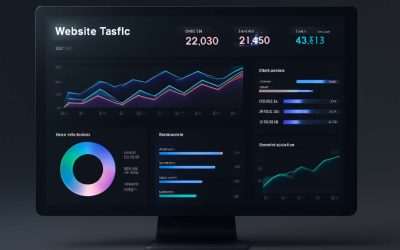Understanding Website Traffic and Its Importance
Defining Website Traffic – What is website traffic and why it matters for SEO
Understanding website traffic is like peering into the heartbeat of your digital presence. It reveals not just the number of visitors but also the quality of engagement, the pathways they take, and the content that resonates most. In the realm of SEO, knowing how to track website traffic transforms raw data into strategic gold, allowing optimisation that truly reaches your target audience.
Defining website traffic involves more than just tallying visits. It encompasses the diverse sources—organic search, social media, referrals, and direct visits—that funnel users to your site. For businesses eager to refine their SEO efforts, grasping these nuances is essential. By dissecting traffic patterns, you uncover the behaviours that drive conversions and the barriers that hinder growth.
To deepen your understanding, consider this:
- Monitoring which channels deliver the highest quality visitors
- Identifying keywords that attract organic traffic
- Assessing user engagement metrics, such as bounce rate and session duration
This knowledge empowers you to make data-driven decisions, ensuring every effort on how to track website traffic aligns with your overarching SEO strategy.
Benefits of Tracking Website Traffic – How accurate data can enhance your marketing strategy
Understanding website traffic and its importance goes beyond simple numbers; it’s about uncovering the story behind each visit. Accurate data provides a clear picture of your audience’s behaviour, helping you identify which channels drive quality traffic and which content sparks engagement. When you know how to track website traffic effectively, you gain insights that can revolutionise your SEO efforts.
Tracking website traffic isn’t just about counting visitors—it’s about interpreting patterns and making strategic decisions. For example, monitoring organic search traffic reveals whether your SEO is paying off or if adjustments are needed. Additionally, assessing engagement metrics like bounce rate and session duration shows how well your content resonates with visitors.
By integrating precise tools and analytics, you can prioritise the channels and keywords that truly matter. This targeted approach ensures your marketing strategy remains agile, relevant, and ultimately more successful in reaching your audience.
Key Metrics to Focus On – Page views, sessions, users, bounce rate, and more
Understanding website traffic isn’t just a numbers game; it’s the secret sauce behind making your SEO efforts truly shine. When you learn how to track website traffic effectively, you uncover patterns that reveal what your audience actually cares about. And no, it’s not just about counting visitors—it’s about diving into the data to see what keeps them engaged or sends them running for the hills.
Key metrics to focus on include page views, sessions, and users. Think of page views as the number of times a particular page gets a glance—great for spotting popular content. Sessions tell you how long visitors stay and how they move through your site, while users show the unique visitors behind the numbers. Then there’s bounce rate—the speed at which visitors leave after viewing just one page. A high bounce rate can be a sign that your content isn’t hitting the mark, or maybe your website’s just too slow on the uptake.
Knowing how to track website traffic isn’t just about gathering data; it’s about interpreting it. When you start connecting the dots, you’ll discover which channels and keywords are genuinely driving your SEO success, and which ones need a bit of a nudge. That’s the real magic behind understanding website traffic, and why it’s essential for any savvy digital marketer.
Essential Tools for Tracking Website Traffic
Google Analytics – Setting up and leveraging Google Analytics for comprehensive insights
Understanding how to track website traffic effectively can be a game-changer for your SEO strategy. Google Analytics remains the cornerstone tool, offering unparalleled insights into visitor behaviour. Setting up Google Analytics is straightforward—just create an account, add the tracking code to your website, and you’re ready to start collecting data. Once configured, you can explore comprehensive reports that reveal how users find your site, which pages attract the most attention, and where potential drop-offs occur.
Leveraging Google Analytics for SEO involves diving into real-time traffic, user flow, and conversion paths. It empowers you to identify high-performing content and optimise underperformers. Remember, the goal is to turn raw data into actionable insights. With this approach, understanding how to track website traffic becomes an essential part of refining your digital presence and boosting your search engine rankings.
Alternative Analytics Platforms – Other tools to consider, such as Matomo, Clicky, and Fathom
While Google Analytics dominates the landscape, several alternative analytics platforms can provide valuable insights into how to track website traffic. These tools often offer unique features or simpler interfaces that suit different needs. For example, Matomo is an open-source platform focusing on privacy and customisation, making it ideal for those wanting full control over their data. Clicky provides real-time analytics with a straightforward dashboard, perfect for quick insights. Fathom, on the other hand, emphasises simplicity and compliance, offering clear reports without the clutter.
Understanding these options broadens your perspective on how to track website traffic effectively. Some platforms even allow seamless integration with existing tools, streamlining your SEO efforts. Whether you prefer detailed data or a minimalist approach, exploring different analytics solutions can help you pinpoint exactly how visitors interact with your site. This knowledge is crucial for refining your SEO strategy and boosting your search engine rankings.
Integrating Tracking Tools with Your Website – Best practices for seamless setup and data accuracy
Getting your head around how to track website traffic might sound like a chore, but it’s the secret sauce behind digital success. Implementing the right tracking tools with a seamless setup isn’t just about plugging in code and hoping for the best; it’s about precision and clarity. When done correctly, your analytics become a crystal ball revealing visitor behaviour, bounce patterns, and conversion points.
To ensure accurate data collection, always integrate tracking tools directly into your site’s core. This means placing tracking snippets in the header or footer—preferably where they won’t get lost in the website’s code clutter. Additionally, verify that your tracking code fires on every page and that filters are configured properly to exclude internal traffic. For peace of mind, I recommend conducting a few test visits to confirm data flows correctly into your dashboard. Remember, clean data is the foundation of effective SEO strategy, and understanding how to track website traffic accurately can make or break your optimisation efforts.
Setting Up Website Traffic Tracking
Installing Tracking Codes – How to add tracking snippets to your website
Understanding how to track website traffic is essential for refining your SEO strategy and truly connecting with your audience. The process begins with installing tracking codes—small snippets of code that act as digital footprints, capturing detailed insights about visitor behaviour.
To add tracking snippets effectively, start by accessing your chosen analytics platform—be it Google Analytics or an alternative like Matomo. Once you have your tracking code, insert it into the header section of your website’s HTML. For most content management systems, this can be done via a theme editor or a dedicated plugin.
If you prefer a systematic approach, follow this sequence:
- Obtain the tracking code from your analytics provider.
- Access your website’s backend or CMS dashboard.
- Navigate to the header file or site settings where scripts are added.
- Paste the tracking code just before the closing tag or within designated script sections.
- Save the changes and verify that the code is functioning correctly using your analytics dashboard.
By carefully embedding these snippets, you ensure accurate data collection—crucial for understanding how to track website traffic and improving your SEO efforts.
Configuring Goals and Conversions – Tracking specific actions and goals for SEO analysis
Understanding how to track website traffic extends beyond mere numbers; it unveils the story behind visitor behaviour and reveals the true impact of your SEO efforts. One of the most vital steps is setting up goals and conversions—specific actions that reflect your strategic priorities. These might include form submissions, newsletter sign-ups, or product purchases.
By configuring these goals within your analytics platform, you can monitor precisely how visitors engage with your site, translating data into insights that refine your SEO strategy. Using an ordered list can streamline this process:
- Identify key actions that align with your business objectives.
- Implement goal tracking within your analytics dashboard.
- Define conversion points, such as clicks on specific buttons or page visits.
- Analyse the data to see which channels and content foster the most conversions.
In doing so, you gain a nuanced understanding of how to track website traffic in relation to your objectives—transforming raw data into a powerful tool for growth and optimisation.
Ensuring Data Privacy Compliance – Respecting user privacy and adhering to regulations
In the world of SEO, understanding how to track website traffic isn’t just about crunching numbers — it’s about respecting the digital privacy of your visitors. With data privacy regulations tightening like a corset, navigating this labyrinth requires finesse and, dare I say, a dash of moral integrity. After all, your analytics are only as good as the trust you build with your audience.
To stay on the right side of the law, start by implementing privacy-conscious tracking solutions. This means choosing tools and platforms that prioritise user privacy while still delivering actionable insights. Many analytics platforms now offer anonymised data collection, which strips away personally identifiable information without sacrificing the granularity needed for SEO analysis.
Next, ensure your website has a clear, transparent privacy policy that informs visitors about how their data is being used. This simple act of honesty not only builds credibility but also keeps you compliant with regulations like GDPR and CCPA. Remember, respecting user privacy isn’t just ethical—it’s smart business. By doing so, you’re paving the way for sustainable, trustworthy traffic growth.
Analyzing Website Traffic Data
Interpreting Traffic Sources – Organic, referral, direct, social, and paid channels
Understanding where your visitors come from is essential in mastering how to track website traffic effectively. Traffic sources reveal which channels are driving engagement and which ones need refinement. Organic search, referral links, direct visits, social media, and paid advertising each offer unique insights into user behaviour.
Interpreting these sources helps tailor your SEO strategy. For example, high organic traffic indicates strong search engine visibility, while a surge in social traffic suggests successful social media campaigns. Conversely, a significant number of direct visits might point to brand recognition or repeat visitors.
To analyse traffic sources comprehensively, consider categorising them as follows:
- Organic: Visitors arriving via search engine results
- Referral: Traffic from other websites linking to yours
- Direct: Users typing your URL directly into their browser
- Social: Visitors from platforms like Facebook, Twitter, or LinkedIn
- Paid: Traffic generated through paid ads such as Google Ads
Knowing how to track website traffic by dissecting these channels enables a focused approach to optimise your SEO efforts and boost overall performance.
Assessing User Behavior – Understanding how visitors interact with your site
Understanding user behaviour is the heartbeat of effective SEO. When you delve into how visitors interact with your site, you uncover patterns that can propel your optimisation efforts forward. Are visitors spending time on your key pages or bouncing quickly? Knowing this helps identify what resonates and what needs adjustment.
Tracking tools provide a treasure trove of data—click paths, time spent, conversions—that reveal the story behind each visit. For instance, a high bounce rate on a landing page might signal misaligned content or poor user experience. By examining these nuances, you gain clarity on which areas require attention.
To deepen your analysis, consider segmenting your visitors based on behaviour, such as new versus returning users, or those arriving via organic search versus paid campaigns. This approach offers a layered understanding of user engagement, sharpening your ability to refine your SEO strategy effectively.
Identifying High-Performing Content – Spotting top pages and content for SEO improvement
Unlocking the secrets of your website’s performance begins with knowing which content truly captivates your visitors. By analysing website traffic data, you can identify high-performing pages that serve as the cornerstone of your SEO strategy. These top pages often attract the lion’s share of organic search traffic and demonstrate what resonates most with your audience.
Delving into the behaviour of these pages reveals invaluable insights. For example, you might discover that certain blog posts generate more shares and backlinks, signalling their authority and relevance. Conversely, pages with high bounce rates may indicate misaligned content or user experience issues. Recognising these patterns enables you to fine-tune your content, ensuring it aligns with what your visitors seek.
To streamline this process, tools such as Google Analytics offer features like behaviour flow reports, which visually map out visitor journeys. This makes it easier to see where users spend most of their time and which pages act as gateways or drop-off points. Understanding which content performs best — and why — illuminates your path to SEO excellence.
Leveraging Traffic Data for SEO Optimization
Keyword Performance Analysis – Using traffic insights to refine your keyword strategy
Harnessing traffic data for SEO is akin to unlocking a treasure trove of insights that can elevate your website’s performance. Once you understand how to track website traffic, you gain an intimate view of visitor behaviour, revealing which keywords draw the most attention and which pages serve as your digital storefront’s anchors. This intelligence allows you to refine your keyword performance analysis, shifting focus to high-impact keywords and refining those that underperform.
By analysing traffic patterns, you can identify emerging trends and seasonal fluctuations, enabling your SEO strategy to adapt dynamically. For example, if certain keywords consistently attract more organic traffic, you can optimise your content around them, boosting your search engine rankings. Conversely, spotting keywords with low engagement signals the need for fresh content or revised targeting. Ultimately, leveraging traffic insights transforms raw data into a strategic advantage, ensuring your SEO efforts are both precise and impactful.
Identifying Technical SEO Issues – Data-driven detection of site problems affecting traffic
Understanding how to track website traffic isn’t just about numbers; it’s about uncovering the silent signals that reveal your site’s health. Sometimes, unseen technical issues lurk beneath the surface, silently sabotaging your SEO efforts. Data-driven detection becomes essential to identify these problems before they spiral out of control. For instance, sudden drops in traffic might indicate broken links, server errors, or misconfigured analytics tags that obscure your true visitor numbers.
By closely monitoring your traffic data, you can spot patterns indicative of underlying issues. An unexpected decline in page views or a spike in bounce rates may point toward slow-loading pages or problematic redirects. Using tools such as Google Analytics or alternative platforms like Fathom can help uncover these technical gaps. Regularly reviewing your site’s performance metrics allows you to address issues swiftly, ensuring your SEO strategy remains optimised and your traffic flows smoothly.
Refining Content Strategy – Aligning content creation with traffic patterns and user interests
Understanding how to track website traffic is the secret weapon behind a truly refined SEO strategy. By analysing traffic patterns, you can uncover the hidden signals that reveal what your audience craves and what pushes them away. When you harness this data, you’re not just reacting to numbers—you’re decoding the behaviour of your visitors, turning insights into actionable steps.
Leverage traffic data to refine your content strategy by aligning your creation efforts with what truly resonates. For instance, if certain pages consistently attract high traffic, delve into what makes them successful—be it keywords, topics, or user intent. Conversely, noticing a decline in visits to specific content can prompt a swift overhaul, keeping your site relevant and engaging. Tracking how users interact with your content helps you anticipate trends and stay ahead of the curve, transforming raw data into a narrative that guides your SEO journey.
To streamline this process, consider categorising your insights through structured analysis—such as identifying high-performing content or analysing keyword performance. This approach ensures your content remains targeted and impactful, maximising your traffic potential and keeping your site in the spotlight. Remember, mastering how to track website traffic isn’t just about numbers; it’s about turning those numbers into a powerful compass guiding your SEO evolution.
Monitoring and Reporting Website Traffic
Setting Up Dashboards – Customized views for easy monitoring
Monitoring and reporting website traffic doesn’t have to feel like deciphering hieroglyphs. Setting up dashboards with customised views creates a visual symphony of data that’s easy to interpret at a glance. Think of these dashboards as your command centre—where all the vital statistics are displayed in real-time, allowing you to spot trends and anomalies without diving into endless reports.
To make life even simpler, consider building dashboards tailored to your specific SEO goals. For example, tracking organic traffic, bounce rates, or top landing pages can be neatly organised into widgets or segments, making it effortless to monitor how your website is performing.
Using a combination of visual cues—colour-coded charts, heat maps, and alerts—can turn raw data into instant insights, so you always know how to track website traffic effectively and respond swiftly to any unexpected shifts. After all, a well-crafted dashboard is the difference between being a passive spectator and an active traffic wizard.
Regular Reporting Practices – Establishing routines for data review
Establishing a routine for monitoring website traffic isn’t just about checking numbers sporadically; it’s about embedding a disciplined approach that transforms raw data into strategic insights. When you review your analytics regularly, you develop an intuitive sense of your website’s behaviour, enabling swift adjustments that can boost your SEO efforts. Consistent reporting practices ensure you stay ahead of trends and identify anomalies before they escalate into issues. Think of it as tending a garden—frequent, attentive care yields a flourishing digital presence.
To streamline this process, many experts recommend setting specific intervals for data review—be it weekly, bi-weekly, or monthly. During these sessions, focus on core metrics like organic traffic, bounce rate, and conversion rates, ensuring your efforts remain aligned with your overarching SEO goals. Incorporating visual cues such as colour-coded charts and heat maps can make the data more digestible, highlighting patterns that warrant attention. Remember, knowing how to track website traffic effectively hinges on establishing a routine that turns data review into a vital, almost instinctive, part of your SEO workflow.
Using Alerts and Notifications – Proactive approach to sudden traffic changes
In the fast-paced world of SEO, staying ahead means being alert to sudden shifts in website traffic. Setting up alerts and notifications transforms reactive analysis into proactive management. When you receive immediate updates about unusual traffic spikes or drops, you can act swiftly—whether that’s investigating technical glitches or capitalising on a viral moment. Automated alerts serve as your digital watchdogs, ensuring you’re never caught off guard.
Many analytics platforms allow you to configure custom notifications based on specific thresholds. For example, if your organic traffic plummets unexpectedly, an alert can trigger, prompting an instant review. This proactive approach not only saves time but also sharpens your ability to adapt strategies in real time. It’s a vital part of understanding how to track website traffic effectively, especially in a landscape where user behaviour can change overnight.
- Define key traffic thresholds relevant to your goals.
- Set up alerts within your analytics tool for these parameters.
- Regularly review your notifications to refine the criteria as your website evolves.
By integrating alerts into your routine, you ensure continuous oversight of your traffic dynamics. This way, your SEO efforts remain agile, grounded in real-time data, and capable of responding to the unpredictable nature of digital engagement.

Advanced Tracking Techniques
Utilizing UTM Parameters – Tracking campaign-specific traffic sources
In the intricate dance of digital strategy, understanding how to track website traffic becomes akin to mastering the art of storytelling through data. One advanced technique that elevates this mastery is utilising UTM parameters—tiny, powerful snippets of code that transform anonymous clicks into vivid narratives of campaign success. By embedding these parameters into your URLs, each visitor’s journey from a social media post or email campaign is etched into your analytics with crystalline clarity.
Imagine a tapestry where each thread is a source, medium, or campaign—UTM parameters weave these threads into a coherent picture, revealing which channels truly resonate with your audience. To harness this power, consider creating a structured approach:
- Define clear UTM parameters for each campaign
- Consistently tag all your marketing links
- Monitor the incoming data for patterns and anomalies
By doing so, you transform raw, often chaotic data into a strategic compass, guiding your SEO efforts with precision. Knowing how to track website traffic through this lens reveals not just how visitors arrive, but why they choose certain paths—illuminating the true efficacy of your marketing endeavours and sharpening your SEO strategies with newfound insight.
Implementing Heatmaps and Session Recordings – Deeper insights into user interactions
Understanding how to track website traffic with finesse often feels like deciphering a cryptic manuscript—each visitor’s interaction is a word, a sentence, a story waiting to be uncovered. While basic analytics reveal the who and the where, advanced techniques such as heatmaps and session recordings offer a more visceral glimpse into user behaviour. They’re the digital equivalent of eavesdropping on a lively conversation, revealing not just which pages are popular but exactly how visitors navigate, hesitate, or scroll with rapt attention.
Heatmaps visually capture user focus areas, highlighting hotspots of activity, while session recordings replay individual journeys—moment by moment. This granular data uncovers subtle cues, like a mouse hover that lingers or a click on an unexpected element, which can be invaluable for refining your SEO strategy. Use these insights to identify high-engagement zones or pages where visitors falter, enabling an intuitive adjustment that enhances overall site performance.
To streamline this process, consider implementing ordered steps such as:

- Installing specialised heatmap and session recording tools
- Filtering recordings to focus on target audience segments
- Analyzing recurring patterns and anomalies with a keen eye for nuance
After all, knowing how to track website traffic isn’t merely about numbers—it’s about understanding the human element behind every click and scroll. When you master these advanced tracking techniques, your website transforms from a static digital billboard into a dynamic conversation that continually adapts to your audience’s preferences and behaviours. Truly, it’s the art of listening in on your visitors’ digital dialogues—then responding with precision and insight.
Conversion Tracking and A/B Testing – Optimizing for better SEO results
In the shadowed corridors of the digital realm, understanding how to track website traffic is akin to deciphering ancient runes—each fragment of data a clue to the secrets lurking beneath the surface. While basic metrics whisper their faint truths, advanced tracking techniques unveil the darkened tapestry of user intent and behaviour.
Conversion tracking, for instance, drapes your analytics in the cloak of purpose—revealing which visitors succumb to your call to action or linger in hesitation. When paired with A/B testing, it becomes a ritual of discovery; two variants, one lurking in the shadows, vying for the visitor’s favour. The process is a meticulous dance, where each split test exposes hidden desires, allowing you to refine your site’s whisper, subtly guiding visitors closer to conversion.
By embracing these techniques, you not only see what draws visitors like moths to a flickering flame but also understand how to track website traffic with surgical precision—transforming data into a weapon of optimisation in the eternal struggle for visibility.



0 Comments